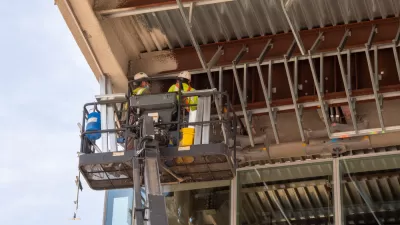Joe Peach explains the technology behind five materials that will dramatically increase sustainability in the building industry. Among the list are wool bricks which are stronger, greater insulators and don't require firing to set.
The building industry is famously slow to partake in the green revolution says Peach, and has long been left behind by advanced technologies available in transit or energy production. However, the future does still mean progress and many exciting innovations are now occurring in the construction industry, which will sustainably address some of the globes growing housing needs.
Scientists in Spain and Scotland found that simply adding wool and a natural polymer found in seaweed to the clay of a brick makes it 37% stronger, and more resistant to the cold wet climate often found in Britain.
Another innovation comes from the world of concrete production, which accounts for a staggering 7-10% of global carbon dioxide emissions. When producing sustainable concrete crushed glass can be added, as can wood chips or slag - a byproduct of steel manufacturing. Whilst these changes aren't radically transforming concrete, by simply using a material that would have otherwise gone to waste, the CO2 emissions associated with concrete are reduced.
FULL STORY: Five Sustainable Building Materials That Could Transform Construction

Manufactured Crisis: Losing the Nation’s Largest Source of Unsubsidized Affordable Housing
Manufactured housing communities have long been an affordable housing option for millions of people living in the U.S., but that affordability is disappearing rapidly. How did we get here?

Americans May Be Stuck — But Why?
Americans are moving a lot less than they once did, and that is a problem. While Yoni Applebaum, in his highly-publicized article Stuck, gets the reasons badly wrong, it's still important to ask: why are we moving so much less than before?

Using Old Oil and Gas Wells for Green Energy Storage
Penn State researchers have found that repurposing abandoned oil and gas wells for geothermal-assisted compressed-air energy storage can boost efficiency, reduce environmental risks, and support clean energy and job transitions.

Greening Oakland’s School Grounds
With help from community partners like the Trust for Public Land, Oakland Unified School District is turning barren, asphalt-covered schoolyards into vibrant, green spaces that support outdoor learning, play, and student well-being.

California Governor Suspends CEQA Reviews for Utilities in Fire Areas
Utility restoration efforts in areas affected by the January wildfires in Los Angeles will be exempt from environmental regulations to speed up the rebuilding of essential infrastructure.

Native American Communities Prepare to Lead on Environmental Stewardship
In the face of federal threats to public lands and conservation efforts, indigenous groups continue to model nature-centered conservation efforts.
Urban Design for Planners 1: Software Tools
This six-course series explores essential urban design concepts using open source software and equips planners with the tools they need to participate fully in the urban design process.
Planning for Universal Design
Learn the tools for implementing Universal Design in planning regulations.
Heyer Gruel & Associates PA
City of Moreno Valley
Institute for Housing and Urban Development Studies (IHS)
City of Grandview
Harvard GSD Executive Education
Salt Lake City
NYU Wagner Graduate School of Public Service
City of Cambridge, Maryland





























